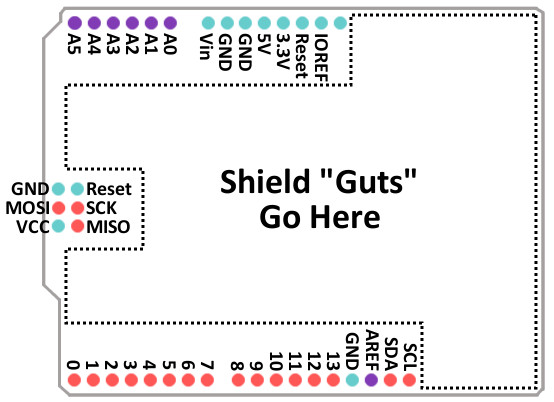
BUT … If you were never into the hardware then you probably know nothing about schematic entry. Verilog is more abstracted away from hardware and that isn’t a problem if you were never into the hardware anyway. Most people that have enough experience to use schematics normally prefer VHDL as the two are closer together. Then it has Verilog which doesn’t make sense again. So not as bad as I suggested but still too big for any reasonable schematic entry. Really … if you don’t need the number of pins then you would choose a smaller package unless you needed more LUTs. Much smaller than I expected for a QFP144.
#Arduino shield series
Posted in Arduino Hacks, FPGA Tagged arduino, fpga, iCE40, ICEZUM, lattice Post navigationĪvailable in three series with LUTs ranging from 384 to 7680 If anyone gets their hands on these boards, let us know, OK? This project is clearly in its very early stages, but we can’t wait to see how it shakes out. Putting an FPGA into an Arduino-compatible form-factor and backing it with an open GUI is an interesting idea. We’ve been seeing FPGA projects popping up all over, and with the open-source toolchains making them more accessible, we wonder if they will get mainstreamed the lure of reconfigurable hardware is just so strong. Everything’s up on GitHub, but not yet ported to KiCad, so you can tweak the hardware if you’ve got a copy of Altium. Still, it’s more I/O than you get on a plain-vanilla Arduino, so we’re not complaining too loudly. One of the main attractions of FPGAs in our book is the tremendous availability of fast I/Os. That leaves around a hundred potential I/Os unaccounted-for.

#Arduino shield plus
There are eight user LEDs on the board, plus the 28 I/O pins that end in pinheaders. The iCE40 FPGA has 144 pins, so you’re probably asking yourself where they all end up, and frankly, so are we. (Hackaday.io has two Arduino clones using SVG pinouts: in SMT and DIP formats.) This is great for attaching small, powered sensors using a three-wire cable like the one that you use for servos. But they’ve also doubled them with pinheaders in a more hacker-friendly layout: SVG - signal, voltage, ground. The Alhambra board itself looks to be Arduino-compatible, with the horrible gap between the rows on the left-hand-side and all, so it will work with your existing shields.
#Arduino shield software
Now we know - it’s the support software for an FPGA “Arduino”. Indeed, we were wondering what the BQ folks were up to when they were working on an easy-to-use GUI for the FPGA family. It’s based on the Lattice iCE40 FPGA, which we’ve covered previously a number of times because of its cheap development boards and open-source development flow. While you can probably do the same with breakout boards, shields will allow you to do it easier and more efficiently.What would you get it you mashed up an FPGA and an Arduino? An FPGA development board with far too few output pins? Or a board in the form-factor of Arduino that’s impossible to program?įortunately, the ICEZUM Alhambra looks like it’s avoided these pitfalls, at least for the most part. Since they stay in place, they are more appropriate for finished projects, especially if you plan on moving them often.Īnother benefit of Arduino shields is that they are built for more complex functions, like GPS and cellular communication systems. They require much less wiring and have fixed functionality for their connections. Shields are essentially building blocks for your projects. In comparison, a breakout board can easily be moved. A shield won’t budge much once it’s connected. There’s a reason for that, and it’s because of the connectivity.

An Arduino shield will be roughly the same size as the Arduino, while a breakout board is usually smaller. The first thing you’ll undoubtedly notice is the size. While they might do similar things, there are significant differences between them. If you already know something about breakout boards , you might wonder why there are both shields and breakout boards. It is taller than headers and thus blocks another shield from fitting properly. In other words, it can stack onto others, but won’t allow others to stack onto it.īig and bulky components are also a dead giveaway that the shield doesn’t allow stacking. If there are none, or they don’t seem aligned correctly, that shield likely doesn’t allow stacking. Keep in mind that not all shields are stackable. This allows you to add even more functionality to your Arduino. If everything is inserted correctly, the shield won’t budge when moved.Īs mentioned before, shields can attach or stack on one another. When attaching a shield to an Arduino board, you will plug shield pins into Arduino’s headers. You plug components and wires in them.Īrduino shields will have long pointy metal pieces on the bottom called pins. When looking at the sides of an Arduino board, you will see two black plastic rows with holes on top.


 0 kommentar(er)
0 kommentar(er)
